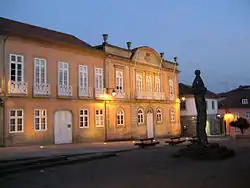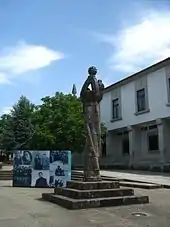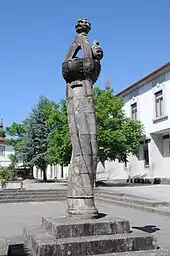| Pillory of Arcos de Valdevez | |
|---|---|
Pelourinho de Arcos de Valdevez | |
 A view of the pillory in the Praça do Município | |
| General information | |
| Type | Pillory |
| Architectural style | Manueline |
| Location | Arcos de Valdevez (Salvador), Vila Fonche e Parada |
| Country | |
| Coordinates | 41°50′46.6″N 8°25′5.3″W / 41.846278°N 8.418139°W |
| Owner | Portuguese Republic |
| Technical details | |
| Material | Granite |
The Pillory of Arcos de Valdevez (Portuguese: Pelourinho de Arcos de Valdevez) is a 15th-century sculpted stone column with symbolic political, administrative and judicial significance, located in the civil parish of Arcos de Valdevez (Salvador), Vila Fonche e Parada, municipality of Arcos de Valdevez.
History


On 4 March 1476, the title of Viscount of Vila Nova de Cerveira was bestowed on D. Leonel de Lima, by King D. Afonso V.[1] Over time Lima became the signeurial master of Arcos de Valdevez.[1]
The group is Manueline in style, architecturally, but also because of the ornamental elements identifying regal heraldry.[2] It is also important to highlight the inscription, authored by João Lopes-o-Velho, who was active in northern Portugal and Galicia, between the 16th century and about 1559.[2] Although there is no clear date, it is frequently referred to as dating from 1531 (António Matos Reis, 2000), suggesting its late Gothic and Manueline influences.[2]
The settlement of Valdevez was, until the 12th century, the seat of the territory of Ribeira-Lima, due to its strategic position between northern Portugal and Galicia.[2] During the Middle Ages, the local administration began to concentrate in Arcos, which was (as its name implies) founded near the old bridge crossing the Vez River.[2] There were some authors that referred to its first foral, issued by D. Afonso Henriques in 1129, but the only document was the Manueline letter.[2] King D. Manuel issued the first foral (charter) to the town, resulting in the later-construction of the pillory, by master stonemason João Lopes.[1][2]
Until 1700, the pillory was in the centre of the municipality, but was transferred to Valeta, a site on the bank of the Vez River.[1][2] During its "stay" in Valeta it was the centre of community life, with stories of young girls who washed clothes near the site, play or date, with a few notes transcribing:[1]
- Pelourinho da Valeta / vai-te deitar e dormir, / não sejas alcoviteiro / das criadas de servir
- Pillory of Valeta / you will lie down and sleep, / do not pander / the maids to serve
By 1706, the area was known as the settlement of the Viscounts of Vila Nova da Cerveira.[1] In the square of the municipality, was a golden pillory, which was moved to the nearby riverbank.[1][2] This site had a judge, three aldermen and prosecutor, six judicial notaries, a judge for orphans, clerk, bailiff, two porters, municipal clerk, and some officers presented by King and others by the Viscount.[1]
From the Memórias Paroquiais (dated 20 April 1758), abbot Miguel de Sousa described that the parish was part of the comarca of Valença.[1] It had 135 neighbours and approximately 480 residents.[1]
By the initiative of the municipal president, Pedro Pereira de Sousa e Brito, in 1895 the pillory was placed in its current location.[1]
Architecture
The pillory is situated in an isolated, urban position, in the historical centre of the town, in a square that is at a lower level then the southern facade of the parochial church. Nearby are two stone bunks.[1][2]
The pillory is a granite structure, composed of a shaft on a four-step quadrangle, with small torus and shaft.[2] A thick column comprising three smaller, addorsed columns, surmounted with frieze and caption:[1][2]
- IOANS / LOPEZ / MEFEZ
The capital is in the form of a bowl, with three shields of Portugal, interspersed with oval frames and surmounted by three rods.[1][2] The three rods replicate the same alignment of small columns converge to an armillary spheres. Another, larger, decorates the group.[1][2]
References
Notes
- 1 2 3 4 5 6 7 8 9 10 11 12 13 14 15 Noé, Paula (1992), SIPA (ed.), Pelourinho de Arcos de Valdevez (IPA.00002221/PT011601340005) (in Portuguese), Lisbon, Portugal: SIPA – Sistema de Informação para o Património Arquitectónico, retrieved 5 September 2016
- 1 2 3 4 5 6 7 8 9 10 11 12 13 14 IGESPAR, ed. (2016), Pelourinho de Arcos de Valdevez (in Portuguese), Lisbon, Portugal: IGESPAR - Instituto Gestão do Patrimonio Arquitectónico e Arqueológico, retrieved 5 September 2016
Sources
- Almeida, Carlos Alberto Ferreira de (1987), Alto Minho (in Portuguese), Lisbon, Portugal
{{citation}}: CS1 maint: location missing publisher (link) - Aurora, Conde d' (1959), Roteiro da Ribeira Lima (in Portuguese), Porto, Portugal
{{citation}}: CS1 maint: location missing publisher (link) - Capela, José Viriato (2005), As freguesias do distrito de Viana do Castelo nas Memórias Paroquiais de 1758 (in Portuguese), Braga, Portugal: Casa Museu de Monção/Universidade do Minho
- Cardoso, Nuno Catarino (1935), Pelourinhos do Minho e Douro (in Portuguese), Lisbon, Portugal
{{citation}}: CS1 maint: location missing publisher (link) - Chaves, Luís (1938), Os Pelourinhos (in Portuguese), Lisbon, Portugal
{{citation}}: CS1 maint: location missing publisher (link) - Chaves, Luís, Os Pelourinhos do Distrito de Viana do Castelo (in Portuguese), Lisbon, Portugal
- Costa, António Carvalho da (Padre), Corografia Portugueza… (in Portuguese), vol. I, Lisbon, Portugal: Valentim da Costa Deslandes
- Crespo, José (1981), "Pelourinhos", Cruzeiros Forcas in Cadernos Vianenses (in Portuguese), Viana do Castelo, Portugal, vol. 6, pp. 97–112
- Gomes, José Cândido (1899), Terras de Valdevez (in Portuguese), Arcos de Valdevez
{{citation}}: CS1 maint: location missing publisher (link) - Malafaia, E.B. de Ataíde (1997), Pelourinhos Portugueses - tentâmen de inventário geral (in Portuguese), Lisbon, Portugal: Imprensa Nacional/Casa da Moeda
- Sousa, Júlio Rocha e (2001), Pelourinhos do Distrito de Viana do Castelo (in Portuguese), Viseu, Portugal
{{citation}}: CS1 maint: location missing publisher (link) - Reis, António Matos (2000), Ponte de Lima no tempo e no espaço (in Portuguese), Ponte de Lima, Portugal
{{citation}}: CS1 maint: location missing publisher (link)